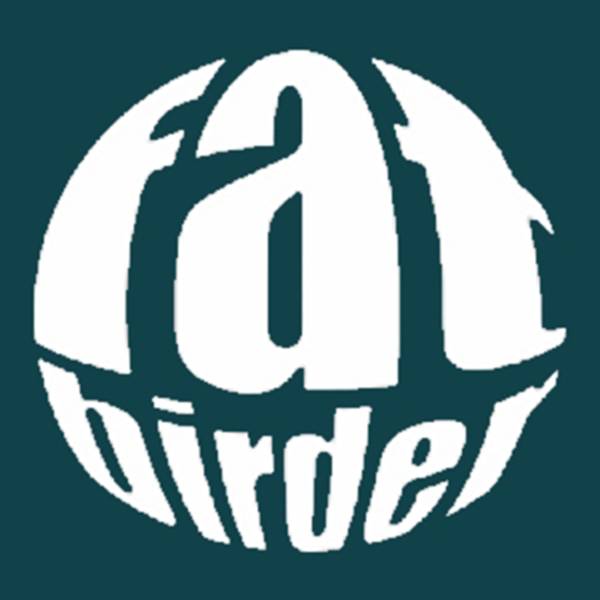Irish Republic
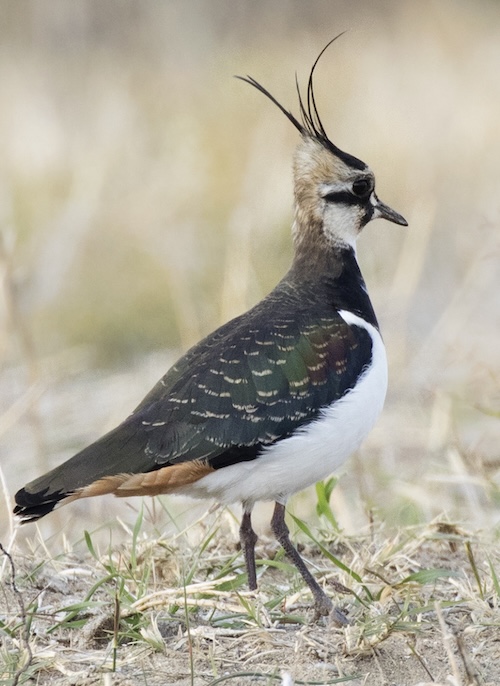
Ireland, also known as the Republic of Ireland is a country in Northwestern Europe consisting of 26 of the 32 counties of the island of Ireland, with a population of about 5.4 million. Its capital and largest city is Dublin, on the eastern side of the island, with a metropolitan population of over 1.5 million. The state extends over an area of about five-sixths (70,273 km2 or 27,133 square miles) of the island of Ireland. The sovereign state shares its only land border with Northern Ireland, which is part of the United Kingdom. It is otherwise surrounded by the Atlantic Ocean, with the Celtic Sea to the south, St George’s Channel to the south-east and the Irish Sea to the east. It is a unitary, parliamentary republic.
The western landscape mostly consists of rugged cliffs, hills and mountains. The central lowlands are extensively covered with glacial deposits of clay and sand, as well as significant areas of bogland and several lakes. The highest point is Carrauntoohil (3,407 feet), located in the MacGillycuddy’s Reeks mountain range in the southwest. River Shannon, which traverses the central lowlands, is the longest river in Ireland at 386 kilometres (240 miles) in length. The west coast is more rugged than the east, with numerous islands, peninsulas, headlands and bays.
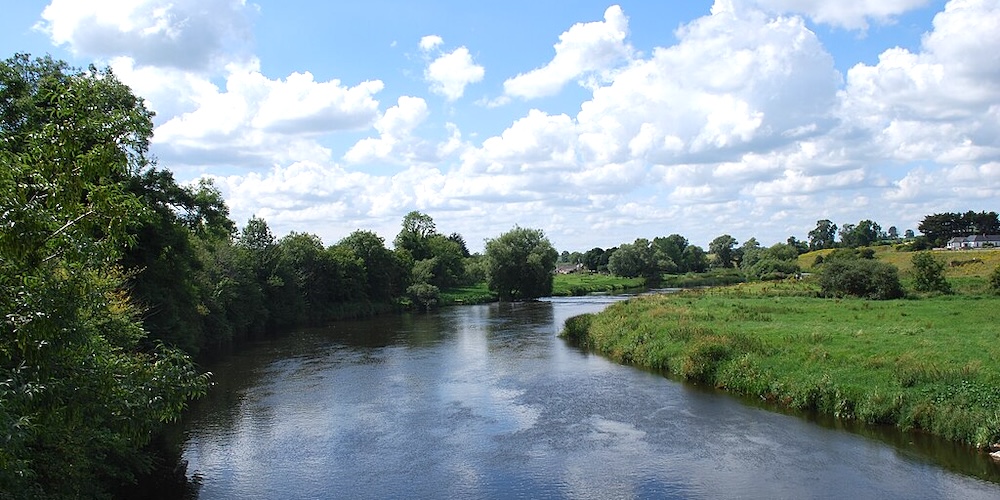
River Boyne – ©Jean Housen CC BY-SA 3.0 via Wikimedia Commons
Ireland is one of the least forested countries in Europe. Until the end of the Middle Ages, the land was heavily forested. Native species include deciduous trees such as oak, ash, hazel, birch, alder, willow, aspen, elm, rowan and hawthorn, as well as evergreen trees such Scots pine, yew, holly and strawberry trees. The growth of blanket bog and the extensive clearing of woodland for farming are believed to be the main causes of deforestation.
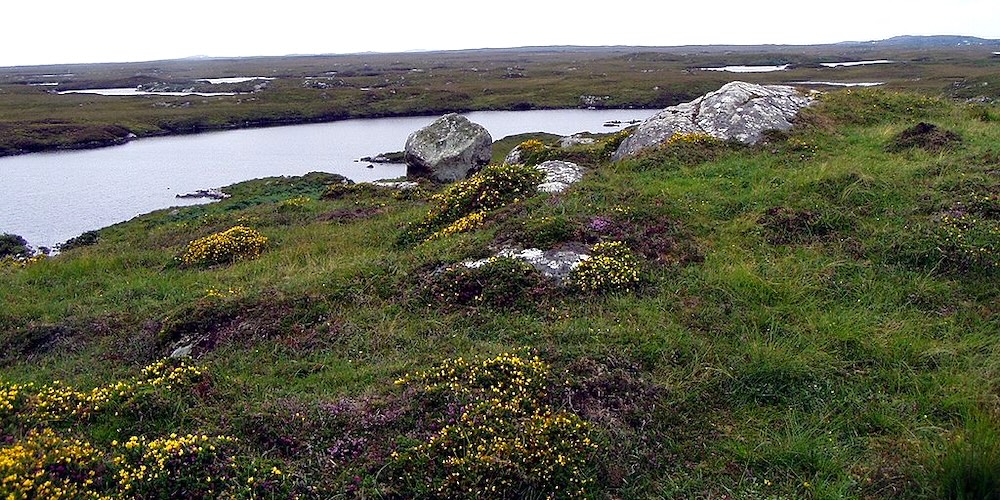
Blanket Gog, Connemara – ©Thorsten Pohl Public Domain via Wikimedia Commons
Today, only about 10% of Ireland is woodland, most of which is non-native conifer plantations, and only 2% of which is native woodland. The average woodland cover in European countries is over 33%. According to Coillte, a state-owned forestry business, the country’s climate gives Ireland one of the fastest growth rates for forests in Europe. Hedgerows, which are traditionally used to define land boundaries, are an important substitute for woodland habitat, providing refuge for native wild flora and a wide range of insect, bird and mammal species. It has two terrestrial eco-regions: Celtic broadleaf forests and North Atlantic moist mixed forests.
Agriculture accounts for about 64% of the total land area. This has resulted in limited land to preserve natural habitats, in particular for larger wild mammals with greater territorial requirements. The long history of agricultural production coupled with modern agricultural methods, such as pesticide and fertiliser use, has placed pressure on biodiversity.
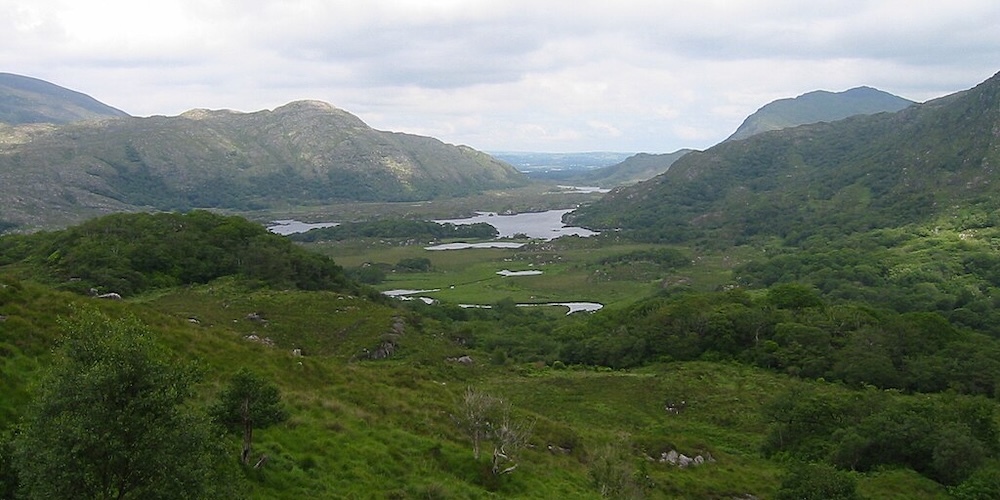
Killarney National Park – ©Kglavin Public Domain via Wikimedia Commons
The Atlantic Ocean and the warming influence of the Gulf Stream affect weather patterns in Ireland. Temperatures differ regionally, with central and eastern areas tending to be more extreme. However, due to a temperate oceanic climate, temperatures are seldom lower than −5 °C in winter or higher than 26 °C in summer. Rainfall is more prevalent during winter months and less so during the early months of summer. Southwestern areas experience the most rainfall as a result of south westerly winds, while Dublin receives the least. Sunshine duration is highest in the southeast of the country. The far north and west are two of the windiest regions in Europe, with great potential for wind energy generation. Ireland normally gets between 1100 and 1600 hours of sunshine each year. The sunniest months are May and June, which average between 5 and 6.5 hours per day over most of the country. The extreme southeast gets most sunshine. December is the dullest month, with an average daily sunshine ranging from about 1 hour in the north to almost 2 hours in the extreme southeast.
Birding Ireland
In comparison to most European countries, Ireland has fewer breeding species. While many of these are migratory, there are also many resident species, common in Europe, that are rare in Ireland. There are several reasons for this. Firstly, Ireland has been isolated as an island for approximately 8,000 years. As a result, many sedentary species including Nuthatches, Willow Tits and Tawny Owls, which do not move great distances, have not managed to cross the Irish Sea. Secondly, Ireland’s mild, wet climate results in a lower winter mortality rate for resident species, allowing such species to commence breeding in the best habitats before many migrants arrive. Therefore, Ireland has fewer available niches for migratory species. Finally, Ireland has fewer habitat types than our neighbouring island. In comparison to Britain, Ireland has less deciduous woodlands and Scots pine forests, while habitats such as heaths, chalk down land and very high mountain ranges are totally absent explaining why birds like Woodlark, Dartford Warbler, Crested Tits and Ptarmigan do not occur here.
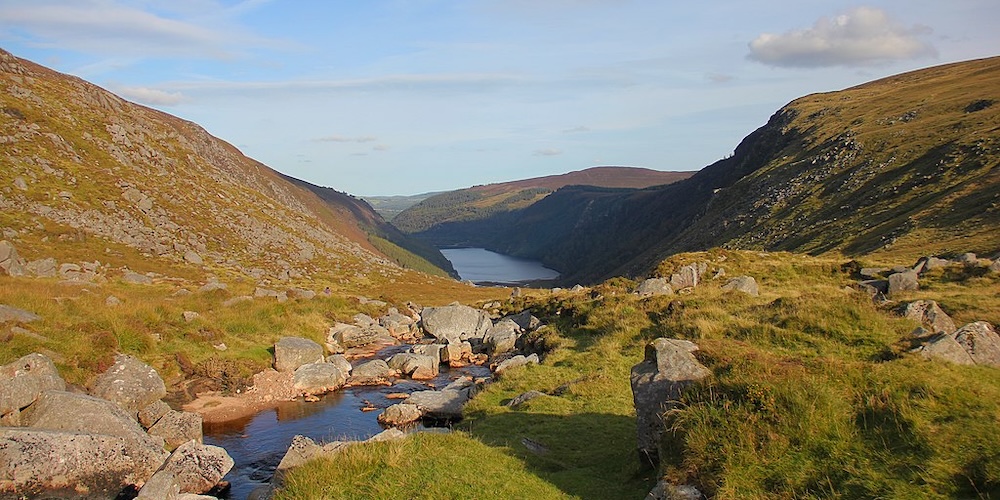
Glendalough Valley, Wicklow Mountains National Park – ©J-H Janßen CC BY-SA 3.0 via Wikimedia Commons
However, Ireland does hold healthy populations of some species that are in serious decline elsewhere in Europe. Dublin and Wexford hold large numbers of Roseate Terns. Of course, the islands and headlands of the rugged western and southern coasts hold enormous seabird colonies, with the largest breeding number of Storm Petrels in the world. Corncrakes have a more chequered history, they were recovering their numbers in the midlands but have again disappeared, while around 150 pairs still breed mostly in the northwest in places like the Erris Peninsula, Islands off the Mayo coast, west Donegal and islands off the Donegal coast such as Tory. Ireland also holds three sub-species of breeding birds, Coal Tit, Jay and Dipper, while the Irish Red Grouse is also considered by some to be a distinct subspecies.
While Ireland’s western geographical location is not ideal for many European migrants, it is perfect for the occurrence of many North American species swept across the Atlantic on their long migration from northeast Canada. Every autumn, waders, gulls and passerines are found in the southern and southwestern counties. In Wexford it is not unusual to encounter five species of Nearctic wader in one day at Tacumshin. In the autumn of 1999, up to nine Buff-breasted Sandpipers were seen together in Wexford. In the same autumn, at least 5 Chimney Swifts, a Common Nighthawk and a Swainson’s Thrush were recorded.

Tory Island Coast – ©Barradeburca123 CC BY-SA 4.0 via Wikimedia Commons
Its westerly location has also made Ireland one of the best sea-watching spots in Europe. Sites like Cape Clear Island in Cork records large movements of Cory’s and Great Shearwaters most years while in recent times Soft-plumaged (Fea’s) Petrels are annual. Other hot spots for sea watching including the Bridges-of-Ross, Co. Clare, and Kircummin Head, Mayo, have become Mecca’s for sea-watchers.
Dominated by the warm Gulf Stream, Ireland enjoys relatively mild and wet winters, making it ideal as a wintering ground for wildfowl and waders. The Wexford Wildfowl reserve holds over half the world’s population of Greenland White-fronted Geese, while the Nearctic influence is still obvious in winter with Ring-necked Ducks seen annually. Each winter large numbers of northern gulls arrive in northern and western counties. Perhaps Killybegs, in Donegal is the most famous with Iceland and Glaucous Gulls occurring in double figures every winter. In recent years smithsonianus Herring Gulls are being found each year while Killybegs has also played host to a superb adult Thayer’s Gull, which attracted a very appreciative audience during its three-week stay.
Despite its apparent lower density of species, Ireland holds one last superb attraction to the visiting birder – solitude. Birding is still in its youth in Ireland and it’s not unusual to spend a mid-week day at one of Europe’s hotspots in perfect weather conditions, at the right time of the year, and not meet another birder. The opportunity of finding your own birds is unique in Ireland.
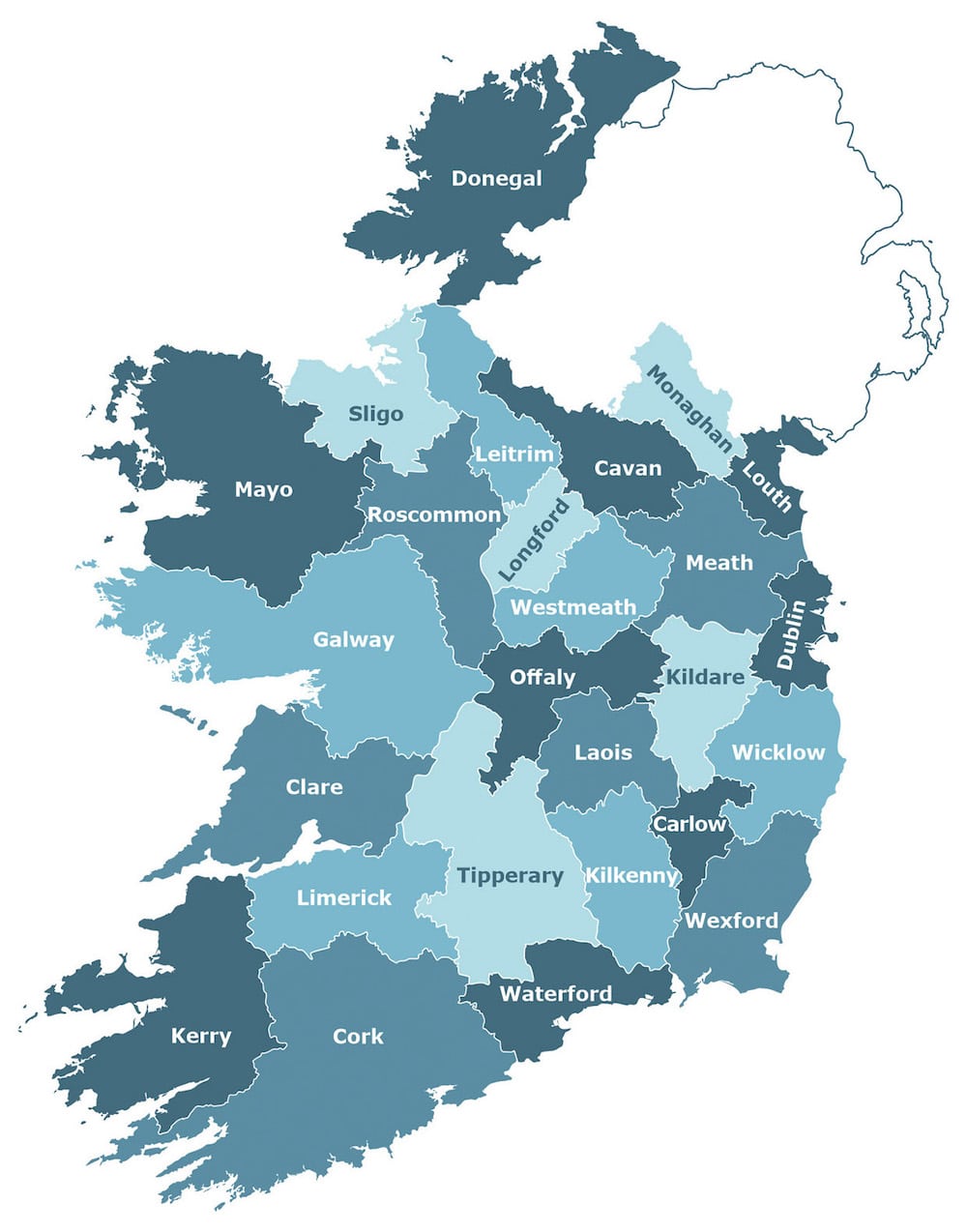
-
Ballycotton, Co. Cork
Satellite ViewLying in east Cork, Ballycotton has entered into the legends of European birding. A mixture of habitat from open bay (with a lighthouse); lagoons, intertidal flats, pools, reed beds and excellent hedgerows and gardens in the town make this an ideal birding venue in spring and autumn. It is the waders that have really placed Ballycotton on the birding map. It defies logic what this small area has produced over the years. Mega birds include Red-necked and Long-toed Stints, Stilt, Least and Broad-billed Sandpipers and Greater Yellowlegs. Regular waders include Baird's, White-rumped, Pectoral, Semi-palmated, Wood and Green Sandpipers, with Temminck's Stints and Kentish Plover also recorded. In addition the area has even produced Stone Curlew, with Red-footed Falcon and Black Kite also seen. On the passerine front, Citrine Wagtail, Greenish Warbler and Lesser Grey Shrike are but a few of the big finds that Ballycotton has unfolded. The whole area is easy to do and the village has a fantastic atmosphere (and some great pubs and B&Bs). And if the weather is bad, and its too wet and windy for the beach, take a look off the back of the cliffs…the sea watching is also excellent with large shearwaters, skuas and Sabine Gulls seen most years. -
Cape Clear Island
Satellite ViewSituated off the southwestern coast of Cork, Cape Clear Island is another of Ireland's hotspots that has acquired legendary status. Reached by a ferry crossing from Baltimore, Cape has operated a manned observatory since 1959. The current obs is situated in the north harbour where the ferry lands. Accommodation is hostel style while holiday homes and B&Bs provide an alternative. Cape's fame is for the number of rare and unusual vagrants that find their way to the island and for the massive seabird movements that occur off the tip of Blanan, Ireland's most southern point. In spring, Cape is best visited from mid-April to late May where European migrants move through the island. Regular spring vagrants include Golden Oriole and Hoopoe, while last year, the island recorded Scop's Owl, Short-toed lark and, if accepted, Ireland's first Calandra Lark. In autumn the best times for visiting begin in early August when the seabird passage begins. During this month it's not unusual to see thousands of Great, Cory's and Sooty Shearwaters, skuas, Storm Petrels with Fea's Petrel seen every year since the mid-90s. In recent years birders have found Wilson's Petrels and Black-browed Albatross. While the seabirds are a great attraction, the autumn on Cape can produce anything from anywhere. In October 1999, birders looking at one of two Little Buntings found Ireland's first Chimney Swift. The list of goodies seen defies listing here but highlights include Yellow-bellied Sapsucker, American Redstart, Red-eyed Vireo's, Yellow-rumped and Blackpoll Warblers etc. Perhaps one of the most incredible sights was of a Pallas's Grasshopper Warbler and a Swainsons Thrush seen in the same bush at the same time. A small piece of this nature simply does not do justice to the superb birding and general great fun of the Cape Clear experience. -
Galway - Top Sites
Belclare Turlough, Lough Atalia, Lough Corrib, Nimmo's Pier, Rahasane Turlough, Rostaff Lake. Rusheen Bay, Tawin -
Great Saltee Island - Co. Wexford
Satellite ViewLying off the coastal village of Kilmore Quay, in south Wexford, the Saltee Islands (Little and Great Saltee) are between 4km and 6km offshore. The Great Saltee was one the first islands in Ireland to have a bird observatory, in recognition of the number of rare passerines seen there each spring and autumn. Landing on the island can be difficult, with no built harbour. Instead it requires a person to climb from the larger boat and be transferred to a small zodiac where you land on the beach if the tide is high. At low tide a clamber across slippery rocks is required. But it's worth it in spring, summer and autumn. In spring the small garden of the only house can hold Golden Oriole, warblers, pipits and flycatchers. In autumn, Red-breasted Flycatchers and hippo warblers are regular vagrants while the open fields are ideal for pipits and larks. Ireland's first Olive-backed Pipit was found on this island, with other notable finds including Black-eared Wheatear, Bluethroat, Barred, Yellow-browed and Dusky Warblers, Wrynecks, Hoopoes, Scarlet Rosefinch etc. However, if you're not into rarities, visit the island in summer when the steep cliffs are home to thousands of seabirds. Kittiwakes, Fulmars, Razorbills, Common and Black Guillemots cram the ledges with Shags everywhere. Everyone's favourite are Puffins that breed on the gentler slopes on the southern side of the island while the Great Saltee also has two large colonies of Gannets. If spending the night (camping); a walk up to the cliff edges in darkness will be an experience not to be forgotten with thousands of Manx Shearwaters landing at your feet. The photographic opportunities are superb. Be warned, the island is privately owned and, while you are welcome to visit, you cannot stay overnight if the owner is on the island. -
North Bull Island, Co. Dublin
Satellite ViewJust outside of Dublin city, this habitat contains tidal mudflats, alder marsh and an extensive dune system. In winter and spring holds large numbers of wildfowl (including pale-bellied Brent Geese) and waders. In autumn, a good passage of Curlew Sandpipers and Little Stint are seen every year. Is also excellent for Nearctic waders with Killdeer, Buff-breasted, Pectoral and Semi-palmated Sandpipers recorded, as well as Wilson's Phalarope. Easily reached by public transport from Dublin city.
-
John Murphy
BirdWatch Ireland, P.O. Box 12, Greystones, Co. Wicklow
+353 [0]1 281 9878
-
Rarities - Paul Milne
100 Dublin Road, Sutton, Dublin
+353 [0]1 832 5653
-
Number of bird species: 522
(As at April 2025)National Bird: Northern Lapwing Vanellus vanellus
-
Avibase
PDF ChecklistThis checklist includes all bird species found in Ireland , based on the best information available at this time. It is based on a wide variety of sources that I collated over many years. I am pleased to offer these checklists as a service to birdwatchers. If you find any error, please do not hesitate to report them. -
BirdWatch Ireland
Annotated ListAlthough a comparatively high number of bird species have been recorded in Ireland, with over 450 species currently on the Irish list, our island biogeography means we have considerably fewer breeding birds than our nearest neighbours. -
E-Bird
PDF ChecklistThis checklist is generated with data from eBird (ebird.org), a global database of bird sightings from birders like you. If you enjoy this checklist, please consider contributing your sightings to eBird. It is 100% free to take part, and your observations will help support birders, researchers, and conservationists worldwide. -
Irish Rare Birds Committee
Annotated ListThe Irish List up to the most recent Irish Rare Bird Report on 31st December 2021 is available to download as a PDF by following the link in the right-hand panel. The Irish List consists of all species included in Categories A, B & C (see below for a description of the Category system) in the geographical area covered by the IRBC and the NIRBC. The sequence and scientific nomenclature largely follows the IOC World List version 12.1 IOC World Bird List (12.1) doi 10.14344/IOC.ML.12.1, replacing the previously referenced BOU British List (British Ornithologists’ Union 2013). -
Wikipedia
Annotated ListThe avifauna of Ireland included a total of 522 species as of the end of 2019 according to the Irish Rare Birds Committee (IRBC).
-
A Field Guide to the Birds of Britain and Ireland by Habitat
| By Mark Golley | New Holland Publishers | 2004 | Paperback | 208 pages, 1000 col illustrations | Out of Print | ISBN: 9781843305767 Buy this book from NHBS.com -
Bill Oddie's Birding Map of Britain and Ireland
| By Bill Oddie | New Holland Publishers | 2011 | Map | Scale: 1.7M, full col photos | Out of Print | ISBN: 9781847739810 Buy this book from NHBS.com -
Bird Atlas 2007-11: The Breeding and Wintering Birds of Britain and Ireland
| By Dawn Balmer, Simon Gillings, Brian Caffrey, Bob Swann, Iain Downie & Rob Fuller | British Trust for Ornithology | 2013 | Hardback | 720 pages, colour photos, colour distribution maps | ISBN: 9781908581280 Buy this book from NHBS.com -
Bird Life in Ireland
| By D Conroy & J Wilson | O'Brien Press | 1994 | Paperback | 208 pages, 16 pp col illus, b/w illustrations | Out of Print | ISBN: 9780862783969 Buy this book from NHBS.com -
Birds of Ireland: Facts, Folklore and History
| By Glynn Anderson | Collins Press | 2017 | Paperback | 360 pages, colour illustrations | ISBN: 9781848893139 Buy this book from NHBS.com -
Collins Bird Guide
| By Lars Svensson | Harper Collins | Edition 3 | 2023 | Paperback | 478 pages, 4000+ colour illustrations, 700 colour distribution maps | ISBN: 9780008547462 Buy this book from NHBS.com -
Field Guide to the Birds of Britain and Ireland
| By Mark Golley |Illustrated by David Daly | Bloomsbury| 2016 | Paperback | 208 Pages | Colour Illustrations | Out of Print | ISBN: 9781472917461 Buy this book from NHBS.com -
Finding Birds in Ireland - The Complete Guide
| By Eric Dempsey & Michael O'Clery | Gill & Macmillan | 2014 | Paperback | 389 pages, 300 colour photos, colour maps | ISBN: 9780717159253 Buy this book from NHBS.com -
Ireland's Birds: Myths, Legends and Folklore
| By Niall Mac Coitir illustrated by Gordon D'Arcy| The Collins Press | 2015 | Paperback | 290 Pages | 24 Colour Plates | ISBN: 9781848892989 Buy this book from NHBS.com -
Ireland's Garden Birds: A Guide to Attracting and Identifying Garden Birds
| By Oran O'Sullivan, Jim Wilson & Mark Carmody | The Collins Press | 2017 | Paperback | 186 pages, 150 colour photos, colour illustrations | ISBN: 9781848893030 Buy this book from NHBS.com -
Photographic Guide to the Birds of Britain and Europe
| By Hakan Delin & Lars Svensson | Bounty Books | 2004 | Paperback | 288 pages, 1300 col photos, 163 illustrations, 465 maps | Out of Print | ISBN: 9780753706893 Buy this book from NHBS.com -
Scarce Migrant Birds of Britain and Ireland
| By JTR Sharrock | T & AD Poyser Ltd (A & C Black) | 2010 | Hardback | 192 pages, b/w photos, b/w illustrations, b/w distribution maps, tables | ISBN: 9781408137383 Buy this book from NHBS.com -
The Birds of Ireland: A Field Guide
| By Jim Wilson & Mark Carmody | The Collins Press | 2013 | Paperback | 272 Pages | ISBN: 9781848891791 Buy this book from NHBS.com -
The Complete Field Guide to Ireland's Birds
| By Eric Dempsey and Michael O'Clery | Gill & Macmillan | 2010 | Paperback | 272 pages, 250 col illustrations | ISBN: 9780717146680 Buy this book from NHBS.com -
The Crossley ID Guide: Britain & Ireland
| By Richard Crossley & Dominic Couzens | Princeton University Press | 2013 | Paperback | 301 pages, 310 plates with colour photos, 250 colour distribution maps | ISBN: 9780691151946 Buy this book from NHBS.com -
The Migration Atlas
| (Movements of the Birds of Britain and Ireland) | Edited by C Wernham, M Toms, J Marchant, J Clark, G Siriwardena & S Baillie | T & AD Poyser Ltd (A & C Black) | 2002 | Hardback | 884 pages, figs, tabs, dist maps | Out of Print | ISBN: 9780713665147 Buy this book from NHBS.com -
The Pocket Guide to the Common Birds of Ireland
| By Eric Dempsey & Michael O'Clery | Gill & Macmillan | 2012 | Paperback | 228 pages, colour illustrations, colour distribution maps | ISBN: 9780717151097 Buy this book from NHBS.com -
Where to Watch Birds in Ireland
| By Paul Milne & Clive Hutchinson | Christopher Helm | 2009 | Paperback | 336 pages | Out of Print | ISBN: 9781408105214 Buy this book from NHBS.com

Collins Bird Guide
AndroidThe Collins Bird Guide App provides everything you need to identify a species quickly and learn about it thoroughly.
Collins Bird Guide
Apple iOS |Collins Bird Guide 4+ A field guide to Europe NatureGuides Ltd. Designed for iPadUseful Information-
Irish Birding
WebsiteIrishBirding.com was initially launched back in 2000 to provide a nationwide web resource for birders in Ireland. With its comprehensive selection of features it provided bird news,photographs and topical articles of interest to Irish birders. As a forum for birders to publish news of sightings and rarity-photographs it proved to be highly popular and received widespread support from Irish birders and visiting birders from abroad.
Organisations-
BirdWatch Ireland
WebsiteBirdWatch Ireland is the largest and most active voluntary conservation organisation in Ireland. Established in 1968, we have over 10,000 active members and more than 20 branches nationwide. Our primary interest is the conservation of wild birds and their habitats in Ireland -
Irish Rare Birds Committee
WebsiteThe Irish Rare Birds Committee (IRBC) is responsible for maintaining a list of the birds recorded in the Republic of Ireland and in addition the inshore waters up to 30km from the nearest land or where relevant, the median point between Ireland and Great Britain. So-called 'At sea' records, i.e. records of birds outside this 30 km limit but still within the Exclusive Economic Zone which extends to approximately 370 km (200 nautical miles) offshore or where relevant, the median point between Ireland and Great Britain are assessed and published by the IRBC in the Irish Rare Bird Report (IRBR), but are excluded from the main list. -
Irish Wildlife Trust
Website -
The Golden Eagle Re-introduction Project
Facebook PageThis five-year project aims to re-introduce golden eagles to Donegal, Ireland, where they became extinct in 1910
Reserves-
*List of Special Protection Areas in the Republic of Ireland
InformationSatellite ViewThe following is a list of Special Protection Areas in the Republic of Ireland known as SPA, as listed by the National Parks and Wildlife Service (NPWS). The Special Protection Areas are designated areas of protection under the European Union Birds Directive and are in place to protect rare and vulnerable bird species, migratory bird species, and wetlands that are deemed to be internationally important. -
BirdWatch Ireland Nature Reserves
WebsiteSatellite ViewAnnotated list of reserves with locations, species, contacts etc -
Local Reserves
Observatory WebsiteSatellite ViewSee the appropriate county page -
National Parks
WebsiteSatellite ViewProtected Sites in Ireland
Sightings, News & Forums-
Irish Birding
News & SightingsSearch sightings by county - IrishBirding.com was initially launched back in 2000 to provide a nationwide web resource for birders in Ireland. With its comprehensive selection of features it provided bird news,photographs and topical articles of interest to Irish birders. As a forum for birders to publish news of sightings and rarity-photographs it proved to be highly popular and received widespread support from Irish birders and visiting birders from abroad. -
eBird
SightingseBirding This Month
Guides & Tour Operators-
BirdsIreland
Tour OperatorBirds Ireland is a company specialising in everything there is to know about Ireland’s birds. Run by husband and wife team, Eric Dempsey and Hazel Johnston, we offer a wide range of services from guided tours and school workshops, to public and corporate speaking events...and lots more. Our offerings are designed to suit both local and visitor alike. Our aim is simple - to share Ireland’s rich diversity of birds and nature with as many people as possible in as many ways as possible.
Trip Reports-
2016 [11 November] - Terry McEneaney & Karen McEneaney
Report...We were able to observe a good cross section of wintering Irish birds, while at the same time seeing an Ireland few visitors have an opportunity to experience. Let’s say we got off the beaten path. Our range of interest was broad and included historic and ancient places such as the site where the Titanic was constructed and last seen off the coast of Ireland; the filming location of the movie “Moby Dick”; the departure site for many Irish emigrants headed to America; a well-rounded view of the Troubles area of Belfast; modern-day Dublin; two famine burial sites; gothic cathedrals; standing stones; ring forts; passage tombs; castles; round towers; stones bridges; and mysterious fairy trees.... -
2017 [01 January] - Janne Aalto
ReportWe parked our car to the only place where the Lough was well visible and started scanning the lake. There were huge numbers of Pochards and Tufted Ducks far on the opposite side of the lake but also about 100 birds on the SE-corner. This smaller flock was in very bad light but anyway we started scanning the birds very carefully. After some searching I found the Lesser Scaup! It was surprisingly easy to identify but it took some time before Hanna also found it as it was swimming all the time and also diving a lot. We followed it for some time until it swam close to the reeds behind some sleeping Tufted Ducks and swimming Coots and Little Grebes. -
2017 [05 May] - Terry McEneaney & Karen McEneaney
ReportIn the 40 years we have been traveling Ireland, this was the greatest contiguous weather event we have ever encountered. It is hard to believe, but it was sunny 8 of the 10 days in the field. Sunny weather and catching unfavourable tides usually means not the best birding. If you wait for the weather or the tides in Ireland you might have a long wait. The birding usually gets harder with the sun glaring or with wind, because some of the forested and open habitat birds go into hiding. But we surprisingly ended up with 101 species of birds (seen and heard) and 8 species of mammals. -
2018 [05 May] - Ireland's Wild Atlantic Coast
PDF ReportWe visited a variety of different Burren habitats, including coastal sand dunes, shingle and salt marsh plus, of course, the unique ones such as turloughs and extensive limestone pavements. We found lots of the special plants, including Pyramidal Bugle (Ajuga pyramidalis), Large-flowered Butterwort (Pinguicula grandiflora) and Denseflowered Orchid (Neotinea maculata), as well as hillsides awash with Spring Gentians (Gentiana verna) and Mountain Avens (Dryas octopetala). As we were blessed with glorious sunshine, the days were filled with the songs of spring passerines, Willow Warbler, Common Whitethroat and Linnets lifted along by the Atlantic breeze, with the distant yet regular echo of Common Cuckoo. A pleasant soundtrack to the gentle pace. -
2018 [11 November] - Terry & Karen McEneaney
Reportvery time we travel to Ireland it is like going into an incredible dream...
Other Links-
Birdsireland.com
WebsiteBirds Ireland is a company specialising in everything there is to know about Ireland’s birds. Run by husband and wife team, Eric Dempsey and Hazel Johnston, we offer a wide range of services from guided tours and school workshops, to public and corporate speaking events...and lots more. Our offerings are designed to suit both local and visitor alike. Our aim is simple - to share Ireland’s rich diversity of birds and nature with as many people as possible in as many ways as possible. -
Birdwatch Ireland Migration
WebsiteBird migration is one of the world`s most extraordinary wonders. Millions of birds travel thousands of miles, only to make the return journey a few months later. -
Birdwatching in Northern Ireland
WebsiteOrnithologists from Britain and Western Europe come to study the birds of Northern Ireland every year, and with good reason. The province`s position on the western fringes of Europe, and the sheer size of many of the flocks that breed or visit, have made it of particular interest both to the experts and the increasing number of birdwatching visitors who are able to combine their special interest with a relaxing holiday in beautiful surroundings. Huge flocks of ducks, waders and geese come south from Arctic Canada and Greenland and other northern vastnesses to pass mild winters on the Ulster wetlands. In spring and summer large numbers of breeding seabirds feed on the fish-rich waters off the north-west coast. Chough and corncrake have some of their last strongholds in Ireland, but are rare in Northern Ireland. -
CJ WildBird Foods
WebsiteCJ WildBird Foods have 20 years experience offering a wide range of high-quality products to help you attract, feed, identify and care for wild birds and other wildlife in your garden -
Irelands Wildlife
WebsiteThe Ireland’s Wildlife website was created and is run by me, Calvin Jones. I’m a lifelong wildlife enthusiast, freelance writer and author based in beautiful West Cork. When I’m not advising business clients about their online marketing and web content, or working on yet another writing project, I love nothing better than getting face to face with Ireland’s wonderful natural heritage. -
Irishbirding.Com
WebsiteIrishBirding.com was initially launched back in 2000 to provide a nationwide web resource for birders in Ireland. With its comprehensive selection of features it provided bird news,photographs and topical articles of interest to Irish birders. As a forum for birders to publish news of sightings and rarity-photographs it proved to be highly popular and received widespread support from Irish birders and visiting birders from abroad. At the end of 2005 other commitments and an imminent move abroad forced the original web master, Eugene Archer, to devote less time to the site but thankfully Joe Doolan acquired the rights to Irishbirding.com in 2007. It is now being relaunched in a new and much improved format. Created by professional web designers and utilising the latest web technology Irisbirding.com is now the most dynamic and interactive web resource available to birders in Ireland.
Blogs
Fatbirder - linking birders worldwide...
Skip to content